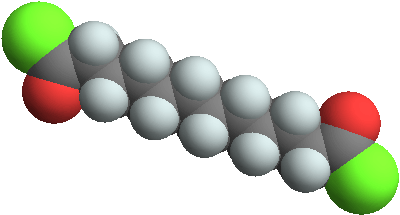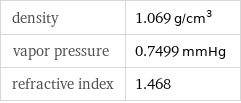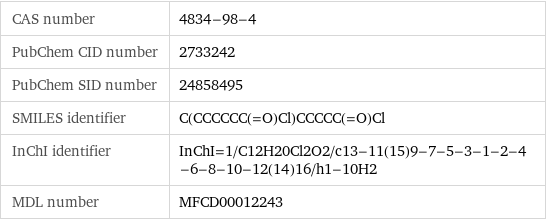Input interpretation

dodecanedioyl dichloride
Chemical names and formulas

formula | ClCO(CH_2)_10COCl Hill formula | C_12H_20Cl_2O_2 name | dodecanedioyl dichloride mass fractions | C (carbon) 53.9% | Cl (chlorine) 26.5% | H (hydrogen) 7.55% | O (oxygen) 12%
Lewis structure

Draw the Lewis structure of dodecanedioyl dichloride. Start by drawing the overall structure of the molecule, ignoring potential double and triple bonds: Count the total valence electrons of the carbon (n_C, val = 4), chlorine (n_Cl, val = 7), hydrogen (n_H, val = 1), and oxygen (n_O, val = 6) atoms: 12 n_C, val + 2 n_Cl, val + 20 n_H, val + 2 n_O, val = 94 Calculate the number of electrons needed to completely fill the valence shells for carbon (n_C, full = 8), chlorine (n_Cl, full = 8), hydrogen (n_H, full = 2), and oxygen (n_O, full = 8): 12 n_C, full + 2 n_Cl, full + 20 n_H, full + 2 n_O, full = 168 Subtracting these two numbers shows that 168 - 94 = 74 bonding electrons are needed. Each bond has two electrons, so in addition to the 35 bonds already present in the diagram add 2 bonds. To minimize formal charge oxygen wants 2 bonds and carbon wants 4 bonds. Identify the atoms that want additional bonds and the number of electrons remaining on each atom: Fill in the 2 bonds by pairing electrons between adjacent highlighted atoms: Answer: | |
3D structure

3D structure
Basic properties

molar mass | 267.2 g/mol phase | liquid (at STP) boiling point | 140 °C (measured at 66.65 Pa) density | 1.069 g/cm^3
Units

Liquid properties (at STP)

density | 1.069 g/cm^3 vapor pressure | 0.7499 mmHg refractive index | 1.468
Units

Chemical identifiers

CAS number | 4834-98-4 PubChem CID number | 2733242 PubChem SID number | 24858495 SMILES identifier | C(CCCCCC(=O)Cl)CCCCC(=O)Cl InChI identifier | InChI=1/C12H20Cl2O2/c13-11(15)9-7-5-3-1-2-4-6-8-10-12(14)16/h1-10H2 MDL number | MFCD00012243
Safety properties

flash point | 110 °C